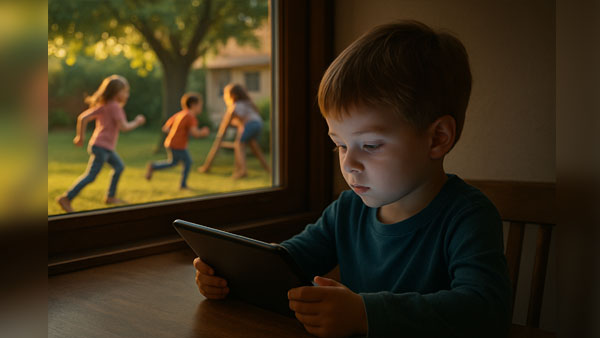By Satyabrat Borah
Nowadays toddlers swipe screens before they utter their first words. The quiet influence of mobile devices on young minds is reshaping childhood in ways we’re only beginning to understand. It’s not just about what’s on the screen like cartoons, games or endless streams of videos but about what childhood is losing in the process. The question isn’t whether screens belong in a child’s life; they’re already there, woven into the fabric of modern existence. The real question is: how much is too much and what are we sacrificing when screens dominate the early years?
Childhood is a fleeting, precious time.Childhood is a period when the brain is a sponge, soaking up experiences that shape a person’s emotional, social, and cognitive foundation. It’s when imagination runs wild, when running through fields or building forts out of blankets sparks creativity and joy. It’s when children learn to read faces, navigate friendships, and feel the warmth of human connection. But today, for many kids, these experiences are being replaced by the glow of a screen. A child clutching a tablet at the dinner table, eyes glued to a game while the world around them fades, is no longer an unusual sight. It’s become the norm. And while technology offers undeniable benefits, the cost of its unchecked presence in young lives is becoming harder to ignore.
The human brain, especially in early childhood, is wired to learn through interaction with people, with nature, with the tangible world. When a child spends hours on a device, they’re often missing out on these real-world experiences that are critical for development. Playing in the dirt, chasing friends in a game of tag, or even arguing over who gets the last cookie teaches lessons no app can replicate. These moments build problem-solving skills, emotional resilience, and the ability to connect with others. Screens, on the other hand, offer a curated, often solitary experience. A game might teach a child to solve a puzzle, but it doesn’t teach them how to negotiate with a friend or cope with losing in real life. The vibrant, fast-paced world of a screen can feel more engaging than the slower, messier reality of human interaction, but it’s the latter that shapes a well-rounded person.
Research paints a sobering picture of what excessive screen time does to young minds. Studies have shown that prolonged exposure to screens can lead to issues like anxiety, depression, and attention deficits in children. The bright lights and rapid-fire stimuli of mobile devices overstimulate developing brains, making it harder for kids to focus on tasks that require patience or sustained effort. For younger children, who are still learning to regulate their emotions, this overstimulation can disrupt their ability to stay calm or process feelings effectively. A 2020 study from the American Academy of Pediatrics found that children under five who spent more than two hours a day on screens were at higher risk for cognitive and language delays. The effects aren’t just short-term; they can alter the brain’s wiring in ways that impact learning and behavior for years to come.
Social skills, like reading body language or understanding tone, are honed through face-to-face interaction. When a child spends more time chatting through a screen or battling virtual enemies than talking to friends or family, those skills can atrophy. Instead of learning to share, empathize, or resolve conflicts in real-time, they’re navigating a digital world where interactions are often one-dimensional. Online games and social media might feel like a connection, but they lack the depth of a real conversation where you see someone’s eyes light up or notice the quiver in their voice. This can lead to a generation less equipped to build meaningful relationships, both personally and professionally.
Physical health takes a hit too. Hours spent hunched over a screen can strain young eyes, leading to issues like digital eye strain or even early myopia. The blue light emitted by devices disrupts sleep patterns, which is especially harmful for children whose growing bodies need rest to thrive. Then there’s the sedentary nature of screen time. Kids who are glued to their devices aren’t running, jumping or climbing.These are the activities that not only keep them physically fit but also boost mental health and creativity. A 2019 study linked excessive screen use in children to higher risks of obesity, as time spent on devices often replaces active play. The outdoors, once a playground for imagination, is increasingly replaced by the virtual landscapes of games and videos.
But it’s not all doom and gloom. Screens aren’t inherently evil; they’re tools, and like any tool, their impact depends on how they’re used. Educational apps can teach kids math, reading, or even coding in engaging ways. Videos can spark curiosity about the world, from documentaries about animals to tutorials on drawing. During the pandemic, screens were a lifeline, connecting isolated kids to their teachers and friends. Without balance, the benefits of technology are overshadowed by its risks.
So, where’s the line? How do we ensure screens enhance rather than erode childhood? It starts with setting boundaries. The World Health Organization recommends no screen time for children under two and no more than one hour a day for those aged two to five. For older kids, the guidelines are less rigid but emphasize balance. Nowadays screens are everywhere. To limit their use can feel like swimming against the tide. It’s even harder when parents themselves are tethered to their devices, modeling the very behavior they’re trying to curb. Kids learn from what they see, and if Mom or Dad is always scrolling, it’s no surprise when a child wants to do the same.
Creating a balanced approach means being intentional about how screens fit into a child’s life. It’s about quality as much as quantity. An hour spent on an app that encourages problem-solving or creativity is different from an hour spent mindlessly watching videos. Parents can guide this by co-viewing with their kids, discussing what they’re seeing, or using apps that spark real-world activities, like a drawing game that inspires them to pick up a pencil. It’s also about carving out screen-free zones like mealtimes, bedrooms, or family outings where human connection takes precedence. These moments help children learn that life happens beyond the screen.
Encouraging alternative activities is just as important. Kids need time to be kids. They have to run, imagine and get bored. Boredom, often seen as a problem to be solved with a screen, is actually a gift. It pushes children to create their own fun, whether it’s building a pillow fort or inventing a game with their siblings. Outdoor play, in particular, is a powerful antidote to the pull of screens. Nature engages all the senses, fostering creativity and calm in ways no device can. Even simple activities like reading together, baking, or telling stories can strengthen family bonds and give kids the emotional security they need to thrive.
The challenge is to preserve the essence of childhood in a screen-saturated world. It’s about ensuring kids grow up with the skills to navigate both the digital and real worlds with confidence. This doesn’t mean banning screens. They’re part of modern life, and learning to use them wisely is a valuable skill. But it does mean recognizing that childhood is a once-in-a-lifetime opportunity to build a foundation for a healthy, fulfilling life. Every hour spent on a screen is an hour not spent exploring, connecting, or simply being a kid. The stakes are high, and the choices we make today will shape not just our children’s futures but the kind of world they’ll create.
As parents, educators and communities, we have a responsibility to strike a balance. We need to ask ourselves: are we giving kids the space to grow into curious, empathetic, resilient people, or are we letting screens rewrite what childhood means? The answer lies in our hands or perhaps, in putting down our phones and picking up a ball, a book, or a moment of connection instead. Childhood is too precious to be lost to a screen’s glow, and it’s up to us to ensure it shines brighter than ever.




